Books in Physical sciences and engineering
Books in Physical sciences and engineering
- 4th Edition
- June 16, 2017
- Laurence W. McKeen
- English
- Hardback9 7 8 0 1 2 8 1 3 2 9 2 0
- eBook9 7 8 0 1 2 8 1 3 2 9 3 7

Film Properties of Plastics and Elastomers
- 1st Edition
- June 16, 2017
- Stephen Gent + 3 more
- English
- Paperback9 7 8 0 1 2 8 0 9 4 8 3 9
- eBook9 7 8 0 1 2 8 0 9 5 1 7 1

Theoretical and Applied Aspects of Biomass Torrefaction
- 1st Edition
- June 16, 2017
- Philip Brown + 1 more
- English
- Hardback9 7 8 0 0 8 1 0 0 5 7 3 6
- eBook9 7 8 0 0 8 1 0 0 5 8 2 8

Fibrous Filter Media
- 1st Edition
- June 15, 2017
- Roger Legg
- English
- Paperback9 7 8 0 0 8 1 0 1 1 2 3 2
- eBook9 7 8 0 0 8 1 0 2 0 9 1 3

Air Conditioning System Design
- 1st Edition
- June 15, 2017
- Debasis Kundu + 1 more
- English
- Paperback9 7 8 0 1 2 8 0 9 7 1 3 7
- eBook9 7 8 0 0 8 1 0 1 2 4 0 6

Analysis of Step-Stress Models
- 1st Edition
- June 15, 2017
- Diego Galar + 1 more
- English
- Paperback9 7 8 0 1 2 8 1 1 1 5 3 6
- eBook9 7 8 0 1 2 8 1 1 1 5 4 3

eMaintenance
- 8th Edition
- June 15, 2017
- William Ribbens
- English
- Paperback9 7 8 0 1 2 8 1 0 4 3 4 7
- eBook9 7 8 0 1 2 8 1 0 4 3 5 4

Understanding Automotive Electronics
- 1st Edition
- June 15, 2017
- Rajkishore Nayak + 1 more
- English
- Hardback9 7 8 0 0 8 1 0 0 9 0 9 3
- eBook9 7 8 0 0 8 1 0 0 9 5 0 5

Manikins for Textile Evaluation
- 1st Edition
- June 14, 2017
- Krishnan K. Sankaran + 1 more
- English
- Paperback9 7 8 0 1 2 8 1 2 0 6 8 2
- eBook9 7 8 0 1 2 8 1 2 0 2 5 5

Metallurgy and Design of Alloys with Hierarchical Microstructures
- 2nd Edition
- June 14, 2017
- Ian Sutton
- English
- Paperback9 7 8 0 1 2 8 1 2 8 8 3 1
- eBook9 7 8 0 1 2 8 1 2 8 8 4 8

Plant Design and Operations